Leaves, Branches, Berries and Blooms

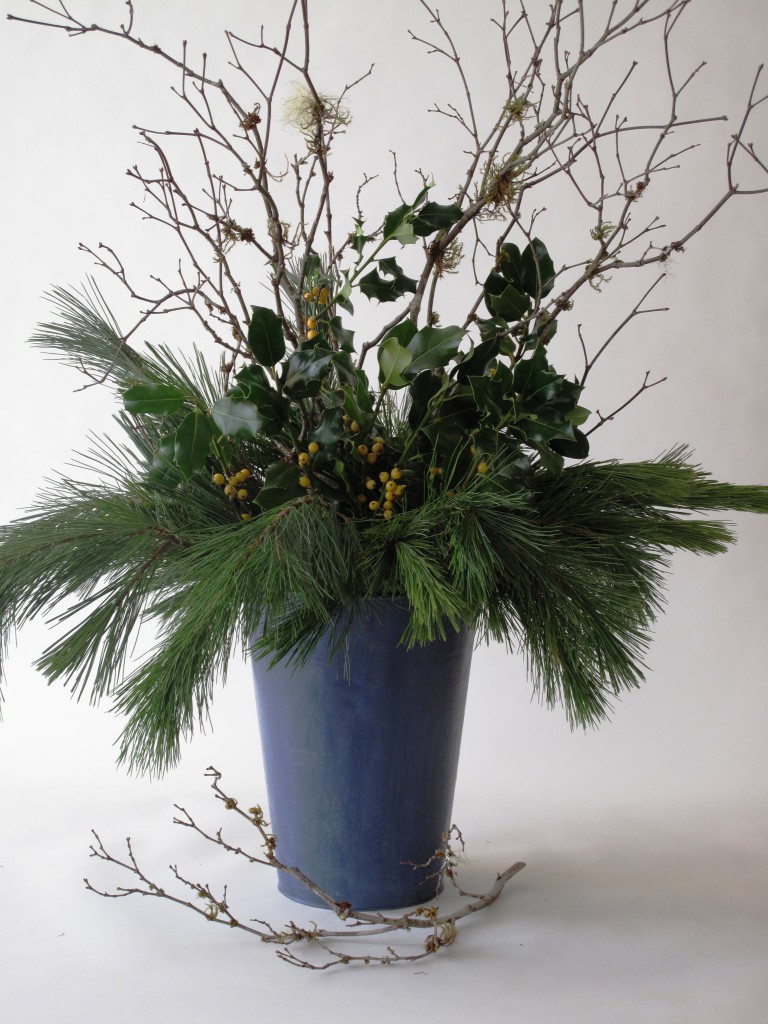
Long-needled lady pine boughs, glossy holly with golden berries, lichen-covered branches – a stunning Holiday arrangement for the season.
As Seen in the December 2013 issue of Better Homes & Gardens
Bring Nature Home for the Holidays!
Aromatic conifers, glossy camellia and magnolia foliage, enticing rose hips and berries,
plus winter blooms, garden roses, beautiful fruit, colorful branches — and more!
In this make-and-take class, you’ll learn how to create a fresh, beautiful, nature-inspired centerpiece for the holiday season. All instruction, supplies and plants are included. Bring your project home and enjoy it for the holidays!
Sparkling beverages and tasty refreshments will be served.
Cost: $95 per person or take advantage of our “bring a friend” special, 2-for-$145
Location: 95 Yesler Collective, 95 Yesler – 3rd floor, Pioneer Square (Seattle, WA)
Copies of Debra’s books “Slow Flowers” and “The 50 Mile Bouquet” will be available
for purchase and she will be happy to personally inscribe them for you.
Pre-registration required:
The Holiday Arrangement & Centerpiece Bar
Friday December 6, 2013 from 6:00 PM to 8:00 PM PST
The Holiday Arrangement & Centerpiece Bar
Saturday December 7, 2013 from 10:00 AM to 12:00 PM PST
Podcast: Play in new window | Download
Subscribe: Apple Podcasts | Podcast Index | RSS | More
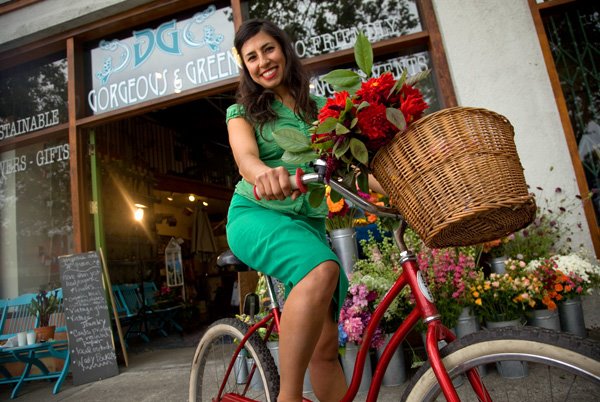
Pilar Zuniga is a Berkeley-based, eco-Green floral designer and outspoken advocate for locally-grown, sustainable flowers and design practices.
Meet Pilar Zuniga, owner of Gorgeous and Green, a Berkeley-based boutique and eco-floral design studio. She’s my guest in this week’s Slow Flowers Podcast with Debra Prinzing.
Pilar started Gorgeous and Green nearly six years ago after she discovered how hard it was to plan her own sustainably-minded wedding. Since then, her venture has expanded from a floral studio designing for weddings and special events to a charming storefront on College Avenue in Berkeley.
There, you can find a full-service floral and gift shop that carries uncommon goods, curated by Pilar, including vintage jewelry, locally-made goods, recycled-paper stationary, organic bath and beauty products — and of course, local and sustainably-grown flowers. Gorgeous and Green recently won the Best of Berkeley 2013 award in the florist category.
For anyone interested in learning how a brick-and-mortar retail flower shop can make it in today’s era of mass merchandising and big boxes, you’ll want to join my conversation with Pilar.
She is blazing a new trail and is the TRUE definition of a LOCAL FLORIST….a hometown, Main Street flower shop that goes the full distance to source from local flower farms in her own backyard.
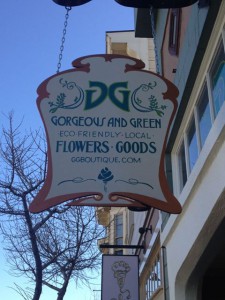 Here’s her answer to the “Why Sustainable”? question:
Here’s her answer to the “Why Sustainable”? question:
A Native American proverb suggests that all that we do today must be done with the next 7 generations in mind.
The mainstream floral and gift industries have many byproducts like pesticide pollution, dependence on plastics, underpaid labor, hazardous working conditions and excessive CO2 Emissions. Additionally, events are the producers of more waste and CO2 emissions. The average wedding emits 12-14 tons of CO2, more than a person emits in a full year.
We can minimize these negative effects by amending our practices to become sustainable ones. For Gorgeous and Green, sustainability means using methods that we can afford to duplicate without negatively affecting the environment and people around us. With a lot of creativity and research, we have been able to develop floral practices and offer gift products that allow us to do just that.
Gorgeous and Green wants to be mindful of not just how we leave our world for the next generation, but how we touch those people and places that were involved in the beauty we created today.
Take a look at our Services section or visit our On-Line Boutique page to see just what we have come up with so far. We’re always creating new ways to save the earth and stay gorgeous.
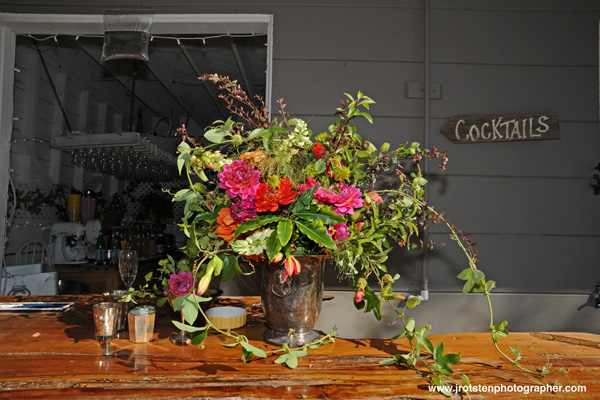
Another yummy seasonal floral arrangement, using California-Grown flowers from farmers Pilar knows and supports.
In the second half of our interview, Pilar and I scratched the surface on a MAJOR topic that’s going on right now in the floral world. It regards the concern she and I — and so many others — have about that green florists’ foam, the crumbly, brick-shaped chunk that you often find stuck inside a vase delivered from a floral wire-service. It is a conventional product that has been around since the Postwar 1950s, developed, so it seems, to make arrangements look fuller using fewer stems of flowers and foliage.
The simple economics have (sadly) led many florists down the rabbit hole of same-old, same-old, unimaginative designs based around the foam. I believe it’s a crutch that limits creativity and certainly hurts the people and environment who encounter it.
Every single week I hear from florists and designers who tell me they are weaning themselves off the product, which is made by a small group of manufacturers in the US and abroad. Those designers are eager to find alternative ways to stabilize stems, such as some that Pilar and I discussed. I will devote a future episode of the Slow Flowers Podcast to more extensive information on this topic.
Pilar was one of the first to speak out and warn florists about the risks of using chemically-based foam. As I mentioned in our interview, every time I did a web search about this topic, her blog posts popped up, as early as 2009. Here are some links you’ll want to read:
(March 4, 2009) Floral Foam: Not so Green
(September 5, 2009) Biodegradable Floral Foam, Where Are You?
(February 18, 2011) Let’s Change Floral Foam
(August 16, 2011) MSDS Floral Foam
If you’re looking for “green” alternatives to floral foam, check out my blog post about Eco-Friendly Design tips, excerpted from Slow Flowers.
Thank you for joining me in this episode of the SLOW FLOWERS Podcast with Debra Prinzing. Because of your support as a listener, we’ve had more than 3,000 downloads since July – and I thank you for taking the time to join to my conversations with flower farmers, florists and other notable floral experts.
If you like what you hear, please consider logging onto Itunes and posting a listener review.
Until next week please join me in putting more American grown flowers on the table, one vase at a time.
The Slow Flowers Podcast is engineered and edited by Hannah Holtgeerts. Learn more about her work at hhcreates.net.
All photographs courtesy of Gorgeous and Green. Thanks Pilar!
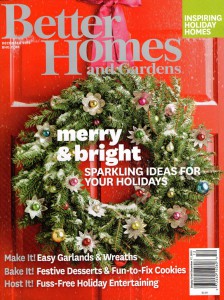
The beautiful cover of Better Homes & Gardens’ December 2013 issue. My “Winter Greens” article and designs appear on pages 58-64.
In the December 2013 issue of Better Homes & Gardens, on newsstands this week, you’ll find a Winter Greenery-inspired story that I produced with photographer Laurie Black. We created this story nearly 3 years ago, and while often there’s no rhyme or reason as to why a piece takes so long to see the light of day, I’m thrilled you can see it now!
This story features four “regionally-inspired” centerpiece designs with flowers, foliage and branches that you might find in Southern California, the Midwest, the South and the Northeast. The fifth idea, a Northwest-style centerpiece, didn’t make it to the pages – but I’ll share those images (mine, not Laurie’s) below.
I owe a huge thanks to editor-in-chief Gayle Goodson Butler for deciding to share my beautiful wintry bouquets with BH&G’s readers in time for their own holiday design projects. I’m also grateful to the magazine’s garden and outdoor living team, including deputy editor Eric Liskey (who originally commissioned the story) and senior associate editor Jane McKeon (who shephered it through the editing process). It takes a village to bring a great idea to the pages of a magazine!
Due to space constraints, like many BH&G articles, there isn’t much real estate on those pages for text – photography rules! So here is the original article as I wrote it – and a few bonus photographs!
Filled with holiday cheer
Wintry centerpieces inspired by what grows in your own backyard
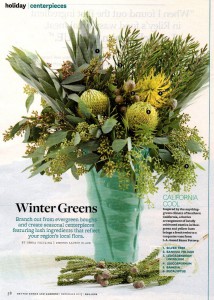
All the California-grown elements to this bouquet come from Wild Ridge Organics in Salinas, Calif. The awesome retro-vase is from Bauer Pottery in Los Angeles.
Decorating with cedar sprays and pine boughs is a cherished holiday tradition for many of us. But this year, why not branch out? Use familiar greenery that reflects your part of the country — the forests, fields, mountains or beaches — to create uniquely local and lush holiday centerpieces. Choose a regionally-inspired vessel and add seasonal foliage, branches and berries paired with blooming plants or forced bulbs. The holiday arrangement will last for a few weeks on your dining table or fireplace mantle. Naturally beautiful, of course.
California Cool
The turquoise glaze of a made-in-California Bauer Pottery vase enhances a blue-green and yellow bouquet. The floral ingredients, all native to Australia and South African but grown in California, are thoroughly adapted to Southwest gardens and bloom from October through May. Seeded eucalyptus and velvety sprays of silver tree (Leucadendron argenteum) serve as foliage, while the arrangement’s drama comes from Banksia and pincushion flowers (Leucospermum sp.).
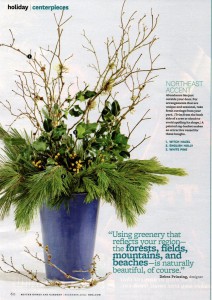
Pine boughs, yellow-berried holly and lichen-covered branches are New England-inspired, gathered into a reclaimed sap bucket.
Northeast Accent
A painted sap bucket seems fitting for this New England-themed winter arrangement, its weathered patina contrasting with the gold berries of the English holly. Long-needled pine boughs cascade over the bucket’s rim while lichen-covered twigs, cut from a deciduous tree, lend height to the design. This elegant arrangement shows how easy it is to combine just three ingredients for impact.
Midwest Spin
Reminiscent of winter at a woodland lodge, a woven pine needle basket is deep enough to hold a nest of fir branches. For texture and color, we chose pussy willows and huckleberry branches, plants typically found growing along streambeds in Minnesota or Montana.
Southern Charms
A classical urn may typically be found outside in the garden, but it has come indoors for the holidays. The vessel contains a thoroughly Southern-themed arrangement. Common boxwood branches create the soft foundation for shiny magnolia boughs.
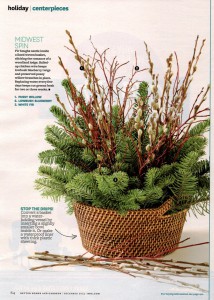
A Midwest-themed arrangement in a woven basket, with textural touches from twigs and pussywillow branches.
We added several lovely amaryllis stems (cut from a potted plant). The buds should look fresh and continue to open for more than a week.
Design tips:
1. Take a walk outdoors: Observe nature and your own backyard to find unexpected ingredients for holiday decorating. When removing branches from the landscape, cut from the back side of a tree or shrub, or take random cuts, so as not to denude your plants. Use sharp, clean pruners. Store branches in a bucket of tepid water until you are ready to arrange them.
2. Choose plants for their design attributes. To create a balanced holiday arrangement, include at least one ingredient that cascades or drapes. Select at least one tall, upright ingredient. And choose at least one dramatic element that gives the design its focal point.
3. Convert interesting vessels a watertight vase. Line containers that have a drainage hole with a slightly smaller plastic bowl. For wood planter boxes, make a waterproof liner with a double layer of thick, plastic sheeting, secured to the inner edge with staples. Double-check for leaks before placing on furniture or a counter.
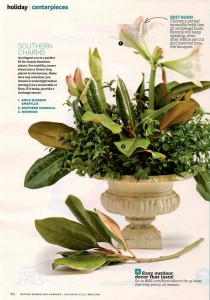
I loved making this Southern-themed bouquet, with evergreen magnolia foliage, boxwood and amaryllis clipped from a potted potted plant.
4. Stabilize woody stems. Place a pin- or cage-style flower frog inside the container to hold branch stems. Or, form a 12-inch length of chicken wire into a loose ball. Insert it inside a container to hold stems in place as your arrangement takes shape.
5. Keep water fresh. Your arrangement will last up to three weeks if it doesn’t dry out. Refresh water every few days. An easy trick is to place the arrangement in your kitchen sink, positioning the faucet or spray nozzle inside the edge. Turn on the water and allow it to gently fill the vase. As it begins to overflow, fresh water will displace the older water. Make sure to dry off the exterior of your vase before displaying it again.
Here’s what you missed! I took these photos while we were producing this story at the home of photographer Laurie Black and her husband Mark King. My friend Nancy Finnerty styled the tabletop for us. It’s such a pretty scene that I had to share.
Adorn your table with local greenery
Bring the bounty of nature indoors to create winter-themed centerpieces for your holiday table. The evergreens that decorate this Sunday brunch repeat the majestic trees seen outside, making a visual connection with the landscape.
From the Northwest
Convert a rustic wood planter box into a low, conversation-friendly centerpiece. First, arrange conifer branches, such as Western red cedar (used here), or sprays of juniper or hemlock, positioning them to drape over the box’s edge. For a creamy-white touch, we added flowers from the winter-blooming lily-of-the-valley shrub (Pieris japonica); red-twig dogwood branches, arranged in irregular clusters, provide a graphic accent.
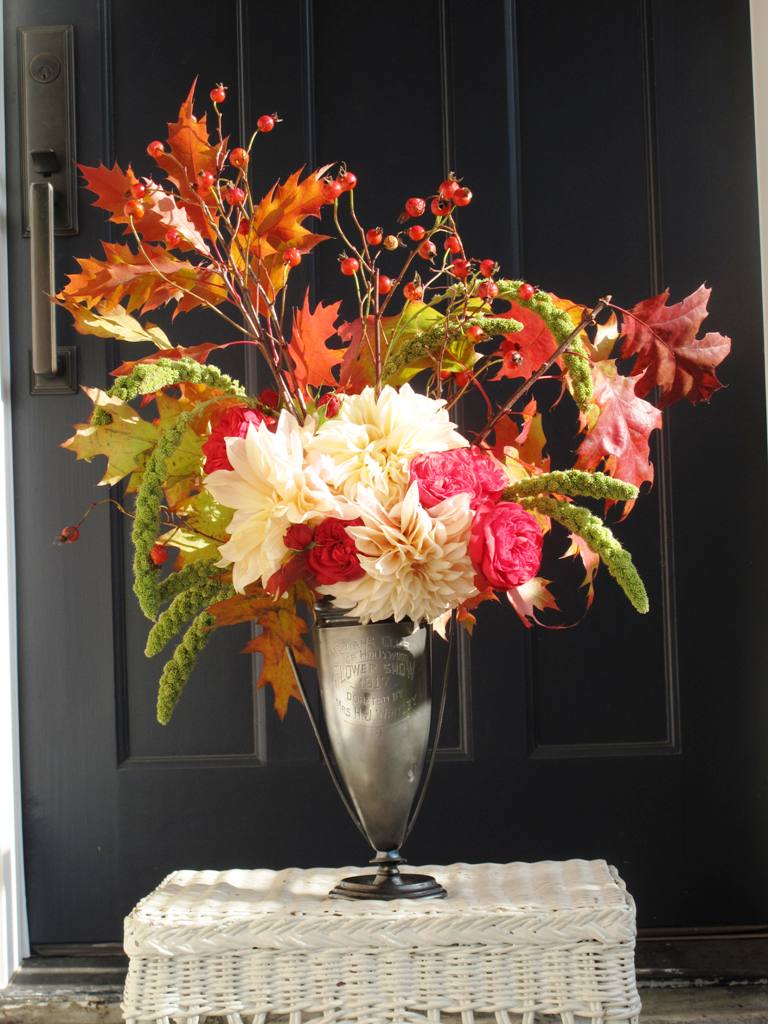
The last flowers of summer, not to mention those like me who love them, are often reluctant to disappear come fall. That was the case with these beautiful Cafe au Lait dahlias.
Ingredients:
Podcast: Play in new window | Download
Subscribe: Apple Podcasts | Podcast Index | RSS | More
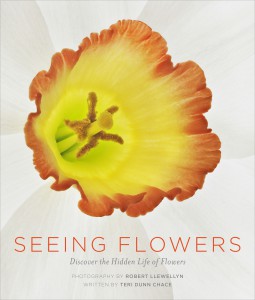 “Enter a rare world of beauty and intricacy,” promises the press release for “Seeing Flowers,” a remarkable new book featuring the highly detailed, almost transparent flower photographs of Robert Llewellyn. Using a unique photo process that includes stitching together large macro photographs, the visual artist reveals floral details that few of us have ever noticed: The amazing architecture of stamens and pistils; the subtle shadings on a petal; the secret recesses of nectar tubes.
“Enter a rare world of beauty and intricacy,” promises the press release for “Seeing Flowers,” a remarkable new book featuring the highly detailed, almost transparent flower photographs of Robert Llewellyn. Using a unique photo process that includes stitching together large macro photographs, the visual artist reveals floral details that few of us have ever noticed: The amazing architecture of stamens and pistils; the subtle shadings on a petal; the secret recesses of nectar tubes.
I learned much more about the secret life of flowers in today’s podcast interview with Teri Dunn Chace, the writer with whom Robert Llewellyn collaborated. A longtime horticultural writer and formerly on the staff of Horticulture magazine, Teri blends literary and scientific sources for her essays about 343 popular flowers.
These are blooms beloved by gardeners and floral designers alike and together Robert and Teri portray flowers as you have never before seen them. They gave me a deeper appreciation of how and why flowers have become so embedded in human culture.
In preparing for my podcast interview with Teri, I went back and spent some time with Robert’s earlier book, Seeing Trees, with writer Nancy Ross Hugo. When that book was released in 2011, I was blown away by the detailed process he goes through to capture the essence of leaves, seeds, pods and other tree parts. Each subject is photographed up to 50 times at various distances and the final work is a composite of the sharpest areas of each individual image. The resulting photographs are of stunning hyper-real clarity, as if Robert has found a way to circumvent the limitations of the human eye through his lens. When Seeing Trees was released, publisher Timber Books created a video of the process.
Please enjoy this conversation with author Teri Chace, and add Seeing Flowers to your library reference shelf. Our conversation is a whirlwind tour of flowers, literature and garden writing. You’ll enjoy the ride.
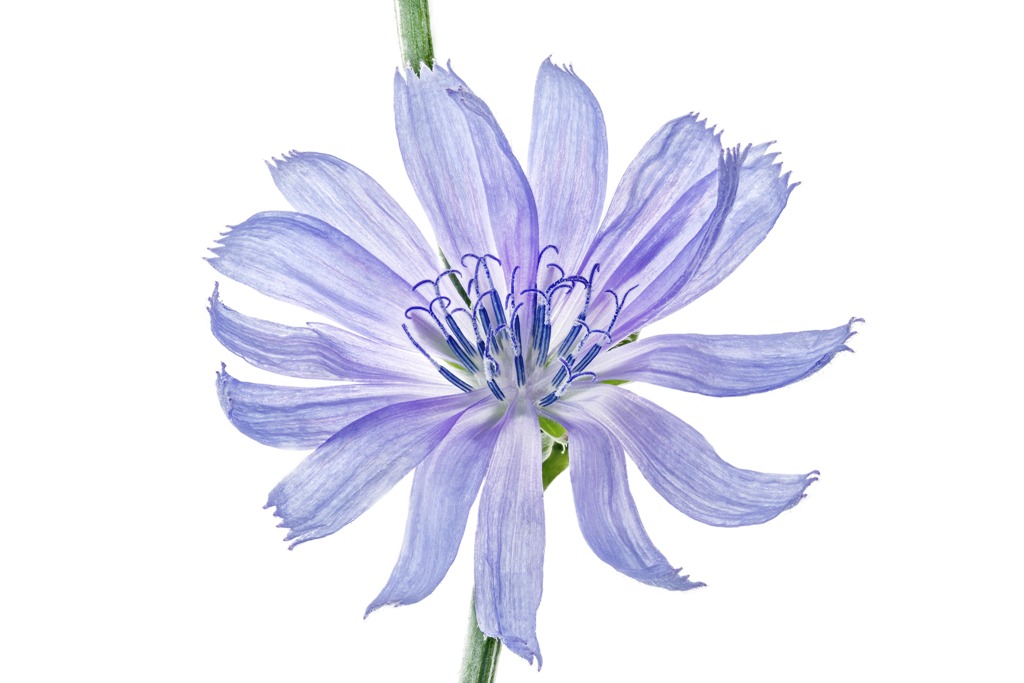
Jaunty blooms of chicory, or Cichorium intybus, open for only a few hours a day. Then the color of the ray flowers rapidly drains away, fading to white. Its dried, ground roots can be used as a coffee substitute.
During my interview with Teri, we read aloud three literary pieces from Seeing Flowers. Here they are for you to read again, interspersed with a few of Robert’s images:
“The rose is a rose,
And always was a rose.
But now the theory goes
That the apple’s a rose
And the pear is, and so’s
The plum, I suppose.
The dear only knows
What will next prove a rose.
You, of course, are a rose —
But were always a rose.”
Robert Frost, “The Rose Family,” 1928

The cup in the center of a daffodil is called a corona. Some are short, like a shallow bowl, while others are longer, more like a trumpet. Some have frilly edges, and some are rimmed with a contrasting color.
“Why do two colors, put one next to the other, sing?
Can one really explain this? No. Just as one can
never learn how to paint.”
Pablo Picasso, Arts de Frances, 1946
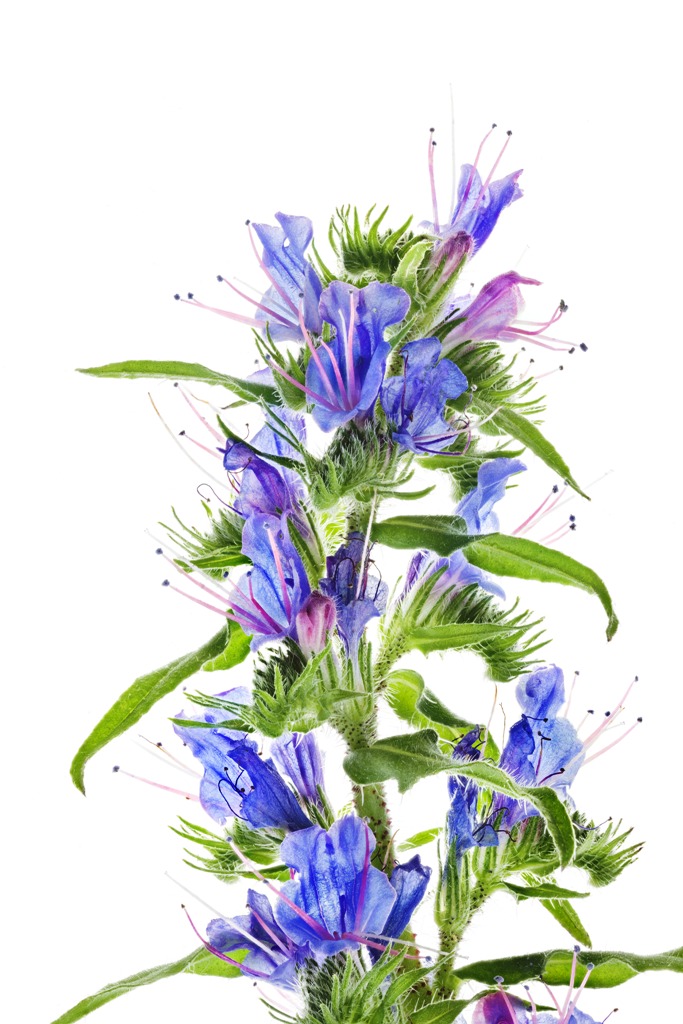
Look past the blue petals of viper’s bugloss, Echium vulgare, and you’ll see that the flowers also feature red stamen filaments and blue pollen. These help them to stand out in form as well as color to pollinators – and to us.
“Ice cream on green cones
white hydrangeas in full bloom
cool the summer day”
Haiku by CDSinex, 2011
ENTER TO WIN: Timber Press is celebrating the publication of Seeing Flowers with an online promotion offering a one-of-a-kind prize. You can enter to win a fine gallery quality print of a photograph from this book. Take a peek at the gorgeous print and the contest details here. NOTE: the Contest Entry Deadline is this Friday, November 15th.
Thanks for joining me in this episode of the SLOW FLOWERS Podcast with Debra Prinzing. Because of your support as a listener, we’ve had more than 2,650 downloads since July – and I thank you for taking the time to join to my conversations with flower farmers, florists and other notable floral experts.
If you like what you hear, please consider logging onto Itunes and posting a listener review.
Until next week please join me in putting more American grown flowers on the table, one vase at a time.
The Slow Flowers Podcast is engineered and edited by Hannah Holtgeerts. Learn more about her work at hhcreates.net.
Ingredients:
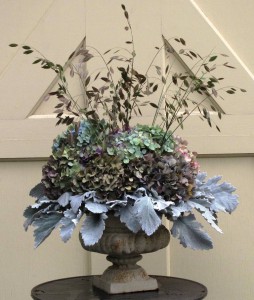
This was the very first arrangement I designed in early November 2011 when I dreamed up the bouquet-a-week-for-a-year project.
Eco-technique
A BONUS BOUQUET: Using some of the same elements, here’s a bouquet I made this week, November 2013. It employs the same weathered urn, hydrangeas, a lacy form of Dusty Miller, rose hips, feverfew sprays and a few Cafe au Lait dahlias. This is a favorite style to which I continue returning. Love it!
Podcast: Play in new window | Download
Subscribe: Apple Podcasts | Podcast Index | RSS | More
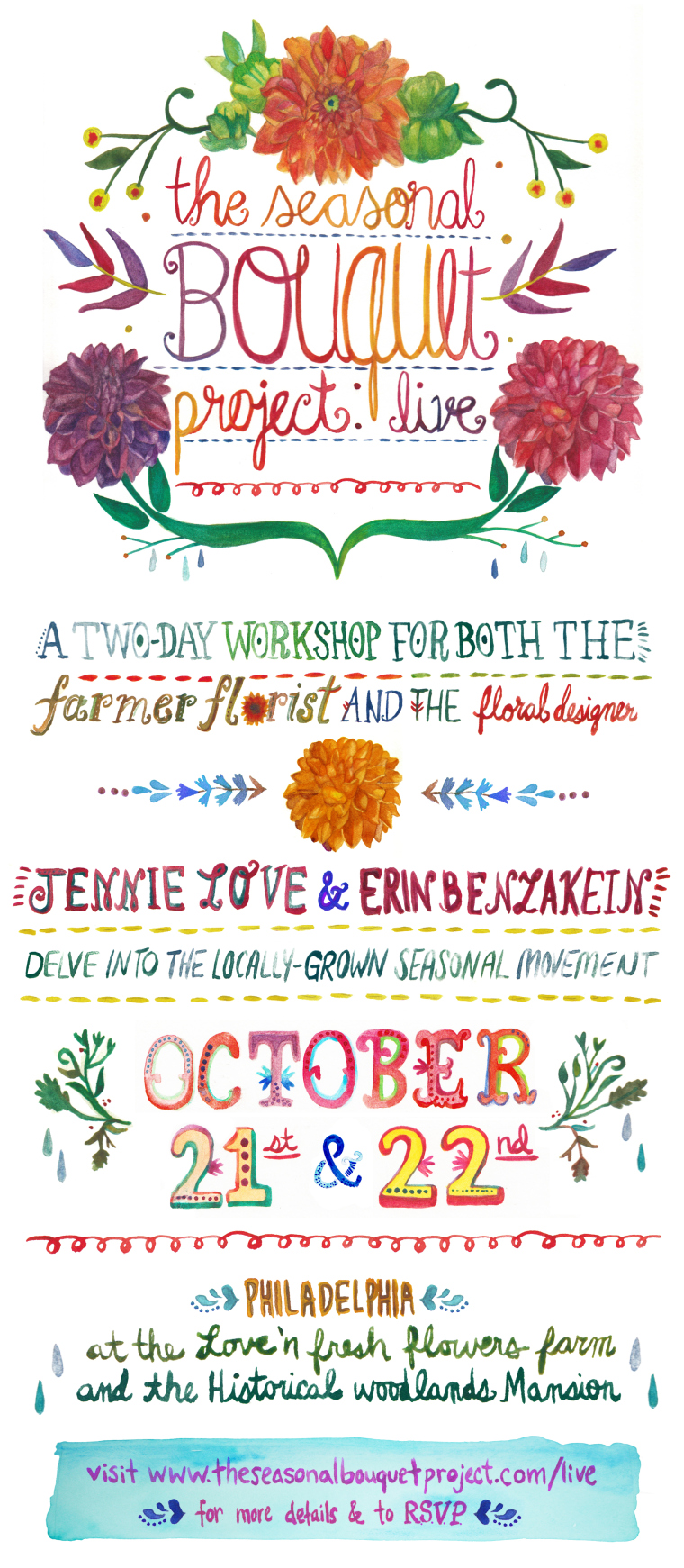
Jennie Love and Erin Benzakein are the dynamic east-west floral duo behind The Seasonal Bouquet Project. This lovely poster was hand-illustrated by Shannon Collins
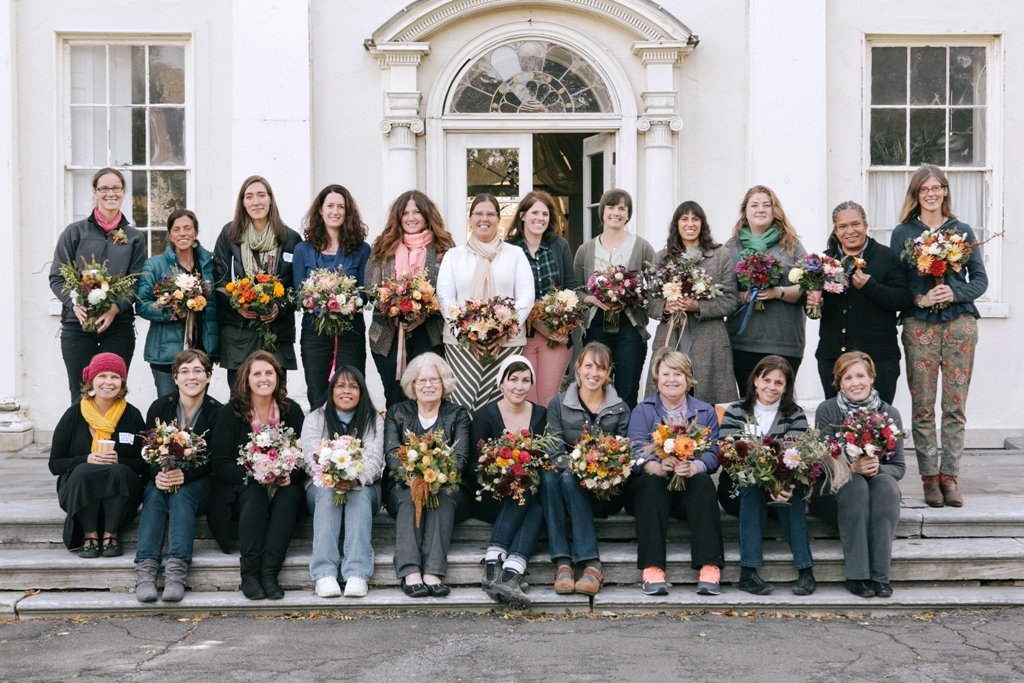
Courtesy of The Seasonal Bouquet Project, a photo from one of Jennie and Erin’s workshops in October. Erin Benzakein is seen 3rd from left, back row; Jennie Love is seen 6th from left, back row.
For the past few years, I’ve been interviewing and writing about a category of designer who I dub the “farmer-florist.”
These include a rare group of individuals in the flower world who are equally talented in the science of growing flowers and the art of designing them.
You’ll meet two of those talented people on today’s podcast, Jennie Love of Love ‘N Fresh Flowers in the Philadelphia area and Erin Benzakein of floret flowers in Washington’s Skagit Valley.
Both Erin and Jennie have been in the business of creating stunning floral art with locally grown materials for several years now. Their west coast/east coast friendship prompted these flower friends to create THE SEASONAL BOUQUET PROJECT in early 2013. Their first post featured yummy, early spring flowers, posted on March 5th.
The Seasonal Bouquet Project emerged from a winter brainstorming session about “how to feed our souls’ fires during the hectic months of the growing season and how to further demonstrate the beauty of locally grown flowers to a wider audience. And, to be completely candid, it’s a bit of a competitive double dog dare between two people who like to have some fun,” according to their website.
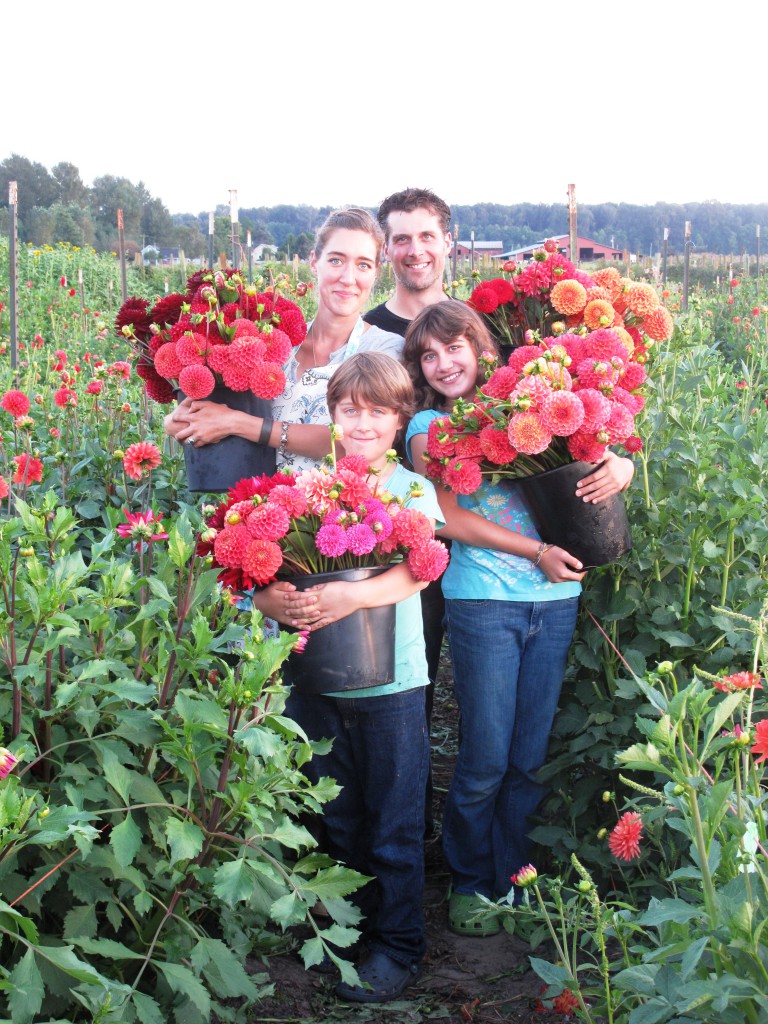
Erin Benzakein, with her husband Chris and children Elora and Jasper. I took this photo last summer at floret flowers, their farm in Washington’s Skagit Valley.
All the materials used in the bouquets were grown within a 25 mile radius of the respective designer, the vast majority coming straight from their own flower fields.
As they wrote on their website: “Since we’re on opposite coasts growing in very different climates, this project is a showcase for what’s available through the seasons across the country.” People all across the country and around the globe, for that matter, followed along on the gorgeous journey. Erin and Jennie also invited readers to post photos of their own bouquets, as long as the ingredients were within that 25-mile radius.
As you will hear in this interview with Jennie and Erin, which took place on October 25th via Skype, the friends cooked up a 2-day workshop to celebrate the “end” of their season. They planned “The Seasonal Bouquet Project LIVE” and scheduled the event to take place on Jennie’s flower farm in Philadelphia. Listen along to hear what happened next – and gain inspiration and insights into the life of a farmer-florist.
Photos to enjoy from Jennie Love and her farm:
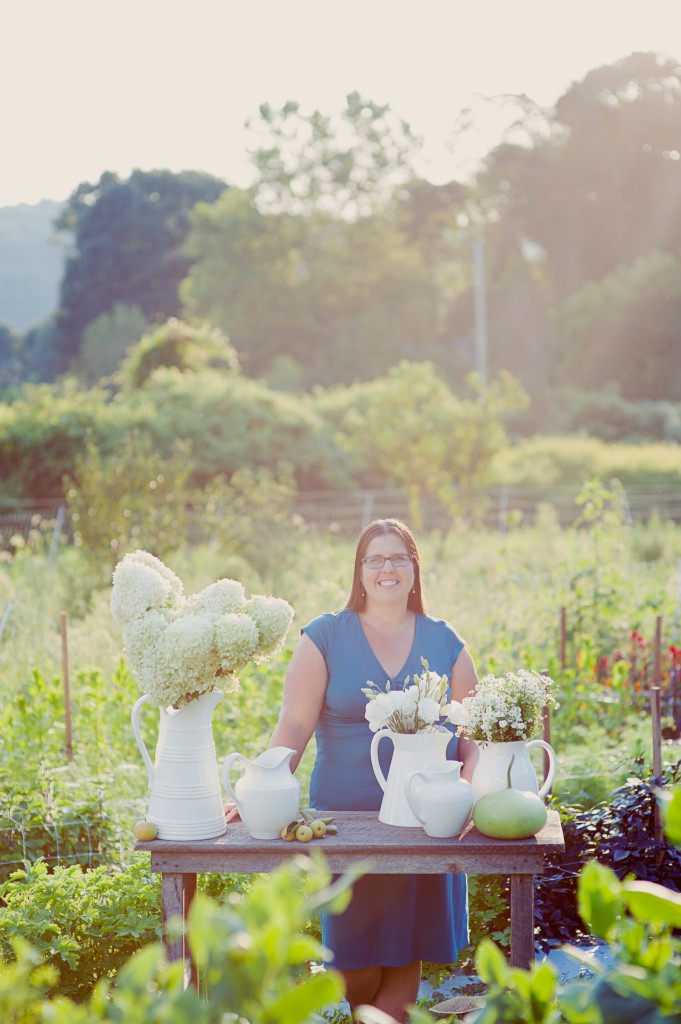
Jennie farms on agricultural land that dates back to William Penn. Photo by Maria Mack Photography ©2012 http://mariamackphotography.com
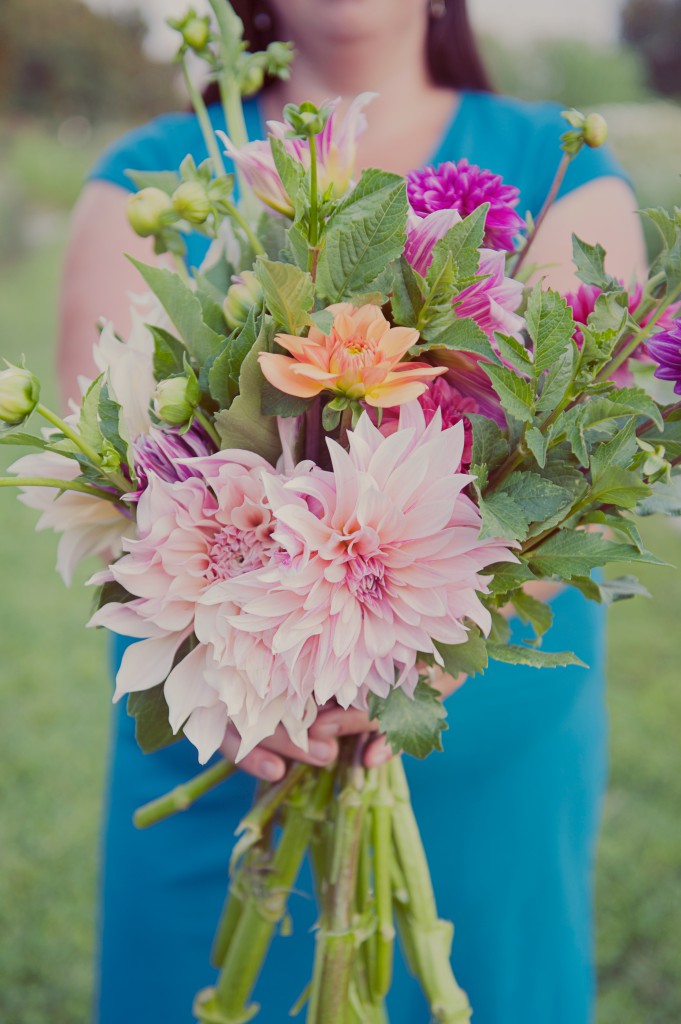
A beautiful summer bouquet, grown & designed by Jennie Love Maria Mack Photography ©2012 http://mariamackphotography.com
Photos to enjoy from Erin Benzakein and her farm:
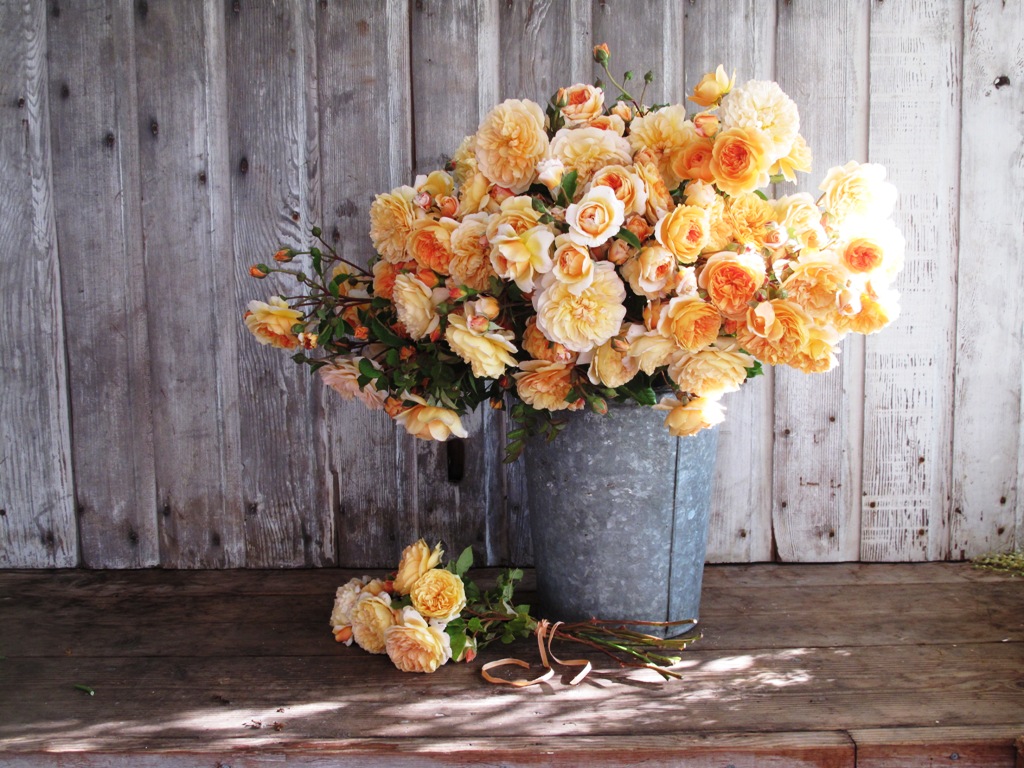
Garden roses at floret flowers, August 2012. I took this shot during our photo shoot for Country Gardens magazine.
Thanks for joining me in this episode of SLOW FLOWERS. Because of your support as a listener, we’ve had more than 2,200 downloads since July – and I thank you for taking the time to join to my conversations with flower farmers, florists and other notable floral experts.
If you like what you hear, please consider logging onto Itunes and posting a listener review.
Until next week please join me in putting more American grown flowers on the table, one vase at a time.
The Slow Flowers Podcast is engineered and edited by Hannah Holtgeerts. Learn more about her work at hhcreates.net.
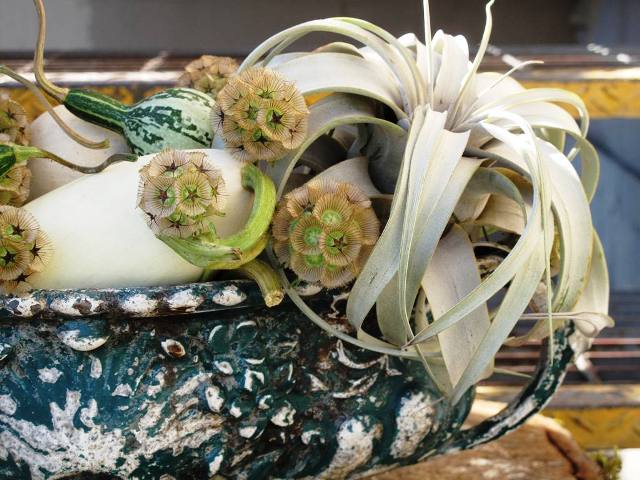
Super-popular tillandsias, especially this ghostly-white species, makes for an interesting fall centerpiece.
Podcast: Play in new window | Download
Subscribe: Apple Podcasts | Podcast Index | RSS | More
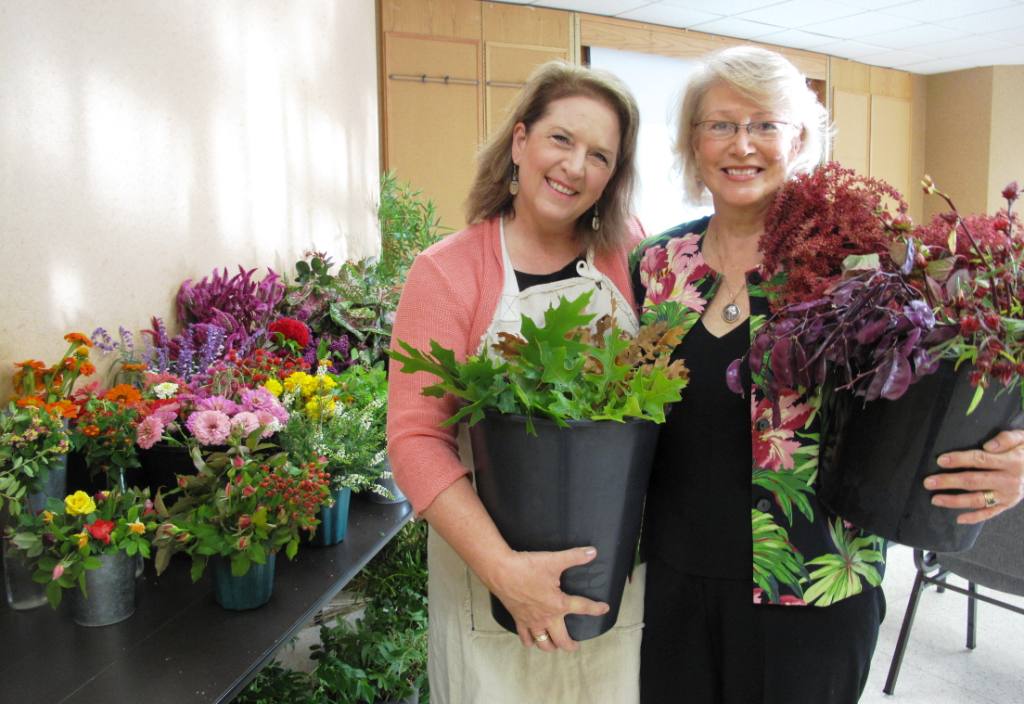
My visit to Ft. Worth this month gave me a wonderful chance to reconnect with flower farmer Cynthia Alexander.
You could call Cynthia Alexander, a “chapter two” flower farmer. A passionate gardener, Cynthia has spent the past several years reinventing herself from a real estate attorney into someone whose relationship with land is exemplified in a completely different way!
Over the past few years, Cynthia and her husband Bob have been transitioning from the city to the land. Quarry Flower Farm, their 120-acre farm, is located in Celina, Texas, about 40 minutes outside of the Dallas-Ft. Worth urban center.
Earlier this month, I traveled to the Ft. Worth Garden Club to lecture about the “Slow Flowers” movement and to lead a workshop for members of the Garden Club’s floral design group. This was my second visit to the Dallas Ft-Worth area to talk about LOCAL flowers and in both cases, my “credibility” was enhanced thanks to Cynthia.
She is a native Texan whose goal is spreading beauty through organic agriculture and the practice of good land stewardship. Her repertoire of ingredients is impressive!
At Quarry Flower Farm, Cynthia grows native Texas shrubs and trees, as well as perennials, annuals, grasses, bulbs, vines and herbs. Her fascination with botanical elements means she has an incredibly diverse list of ingredients for floral fans, everyone from hot floral designers to farm-to-table caterers.
Here is the extensive list of flowers, foliage, herbs, branches and ornamental grasses she provided for the Ft. Worth workshop:
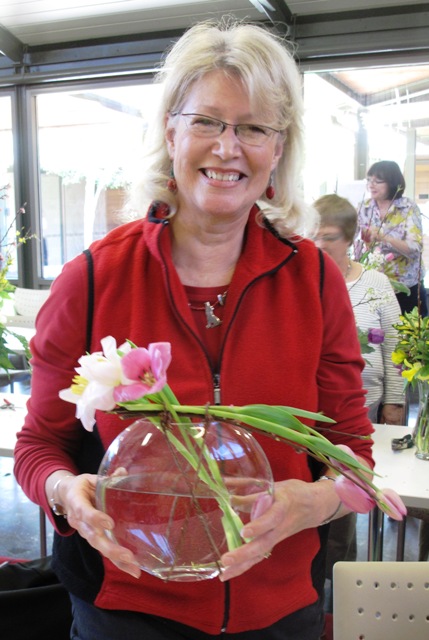
Cynthia’s design talents were evident when we met in 2012 at a field-to-vase workshop I taught at the Dallas Arboretum.
Cynthia first came to my rescue in February 2012 when I taught an eco-floral design course at the Dallas Arboretum. I had contacted her through the ASCFG directory, asking for help. Cynthia showed up with a bevy of flowering bulb varieties and spring branches – much to the delight of the Dallas floral design students. After all, it was FEBRUARY, for goodness sake’s. She saved the day!
The same thing happened when I encouraged the Ft. Worth Garden Club to source LOCAL Texas leaves, branches and flowers from a real flower farmer. Cynthia is a gem. And you’ll find her personal story fascinating.
I mean really….how many people leave a successful, 30-year career as an attorney in order to dig in the dirt and grow cut flowers? For that reason alone, I adore this gifted woman. Enjoy our conversation and listen for all of Cynthia’s advice about her second career – as a cut flower farmer.
Cynthia hosts garden club tours, bridal parties and U-pick guests by appointment during the spring growing season. Check her web site for details.
Other Resources mentioned in our interview:
The Flower Farmer: An Organic Grower’s Guide to Raising and Selling Cut Flowers (Chelsea Green Publishing, 2008), by Lynn Byczynski
Cynthia mentioned that her inspiration began by spending time with Pamela and Frank Arnosky, owners of Texas Specialty Cut Flowers. The Arnoskys have also written an important resource, as well, Local Color: Growing Specialty Cut Flowers.
Association of Specialty Cut Flower Growers is a membership association of flower farmers in every state. The ASCFG has many wonderful resources for beginning and established flower farmers.
Thanks for joining me in this episode of SLOW FLOWERS. Because of your support as a listener, we’ve reached nearly 2,000 downloads since July – and I thank you for taking the time to join to my conversations with flower farmers, florists and other notable floral experts.
If you like what you hear, please consider logging onto Itunes and posting a listener review.
Until next week please join me in putting more American grown flowers on the table, one vase at a time.
The Slow Flowers Podcast is engineered and edited by Hannah Holtgeerts. Learn more about her work at hhcreates.net.
© Debra Prinzing, all written and photographic content. Website design/development by Willo Bellwood/Metric Media